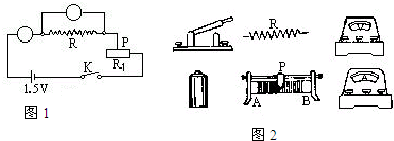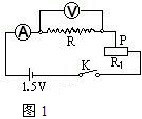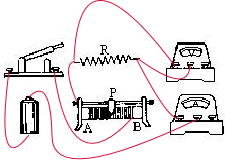如图1电路所示,在测量电阻的实验中,R为镍铬丝,滑动变阻器R1的阻值范围为0~10欧姆. 请回答下列问题:
(1)用符号在电路图中把安培表和伏特表表示出来.
(2)移动滑动变阻器的滑片P,主要是改变______.(选填下列选项代号)
①电池的电压. ②R′两端的电压. ③R的阻值. ④通过R的电流强度.
(3)R两端的电压,最大为______伏特.
(4)在这个实验中,最好选用量程为______的伏特表.(选填下列选项代号)
①100毫伏. ②1伏特. ③3伏特. ④15伏特.
(5)根据以上的结论(R约为3欧姆),用笔画线代替导线把图2的元件连成电路.(画线不要交叉,元件位置不要移动)

(1)与电阻并联的是电压表;
与电阻串联的是电流表,如图所示:

;
(2)滑动变阻器的主要作用是改变电阻两端的电压和通过R的电流,所以④正确;
(3)因为电源电压为1.5V,当滑动变阻器电阻为零时,电阻两端的电压最大,为1.5V;
(4)电阻两端的最大电压为1.5V,所以①②的量程都小于1.5V,不可以;
④的量程太大,测量起来不准确,误差大,所以应选用③;
(5)当滑动变阻器的电阻为零时,电路中的最大电流为I=
=U R
=0.5A,所以电流表应选择0~0.6A的量程;1.5V 3Ω
根据电路图,从电源的正极出发,依次连接开关、滑动变阻器、电阻、电流表,回到电源的负极,电压表与电阻并联,注意电压表、电流表的量程、正负接线柱的接法,同时注意滑动变阻器的接线柱接法,如图所示:

;
故答案为:(1)见上图;(2)④;(3)1.5;(4)③;(5)如图所示.
